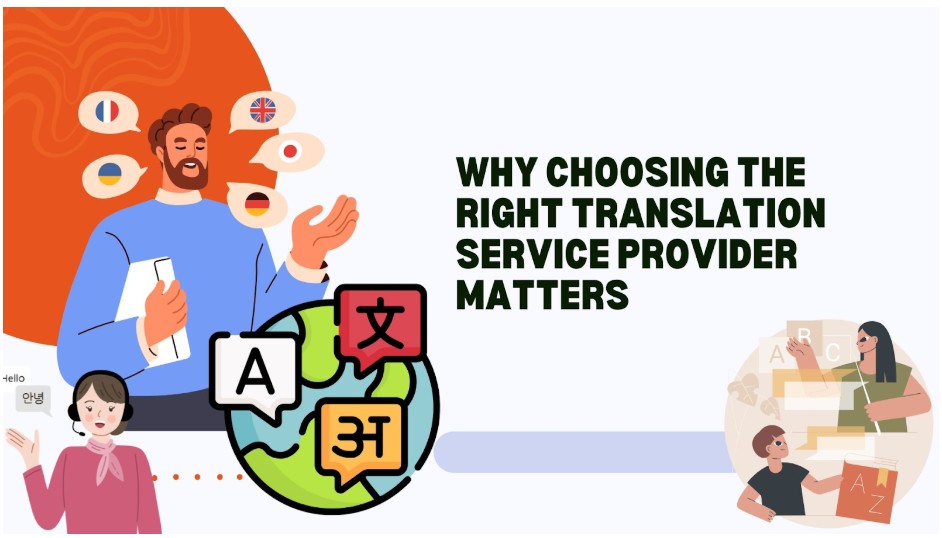Learning a new language is more than just a hobby. It comes with numerous benefits—it’s a gateway to a world of cognitive benefits, career opportunities, and the profound joy of connecting with diverse cultures. Traditionally, though, mastering a new language could come with a hefty price tag, often posing a significant barrier for many aspiring learners.
Enter the game changers: free language learning apps. These digital marvels have democratized language education, offering high-quality instruction at your fingertips without the burden of expensive courses or materials.In this article, we’ll guide you through the top free language learning apps available today, helping you make an informed decision on which one might be the perfect fit for your learning styles and goals.
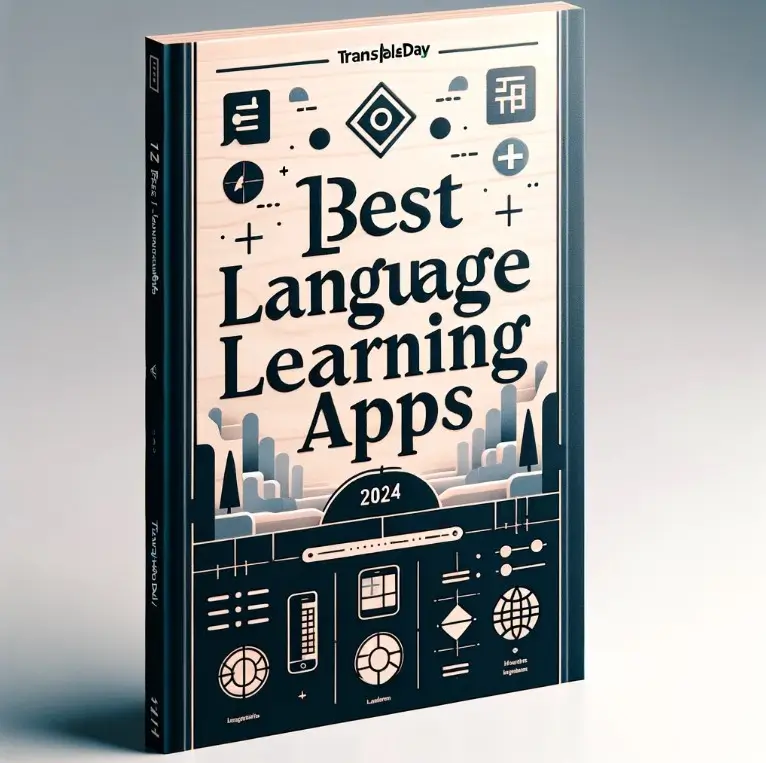
1. Lingvist: Intensive vocabulary and grammar for advanced learners
Lingvist, through a combination of artificial intelligence and data-driven techniques, it personalizes lessons based on a user’s current level and learning speed. These lessons employ spaced repetition, which is proven to reinforce previously learned words and phrases at optimal intervals for memory retention.
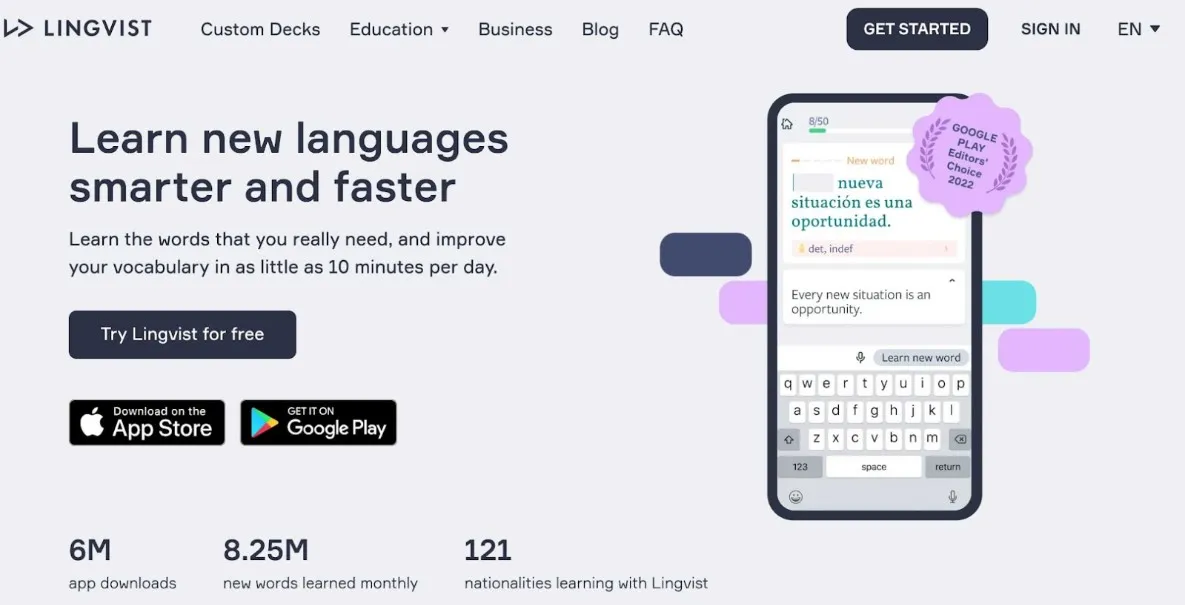
Lingvist is suitable for beginners looking to acquire basic language skills, as well as more advanced learners seeking to enhance their proficiency. Its adaptive approach provides advanced users with comprehensive exercises and complex linguistic content, making it an ideal choice for those aiming to deepen their language skills for specialized exams, advanced academic or professional contexts, or expert-level proficiency.
Lingvist Pros
- Real-World Context: Lingvist emphasizes practical language usage, exposing learners to authentic sentences and phrases, making it ideal for real-life communication.
- Progress Tracking: Users receive real-time feedback and assessments to monitor their progress, helping them identify areas in need of improvement and stay motivated.
- Mobile Accessibility: The mobile version of the app allows learners to practice anytime, anywhere, making it convenient for those with busy schedules.
Lingvist Cons
- Lack of Cultural Content: Lingvist’s primary focus is on language skills, so it may not provide in-depth cultural insights or context, which are essential for a well-rounded language understanding.
- Pronunciation Practice: While Lingvist offers listening exercises, it may not provide extensive pronunciation training, which can be crucial for mastering spoken fluency.
- Internet Dependence: Lingvist relies on an internet connection, which may not be suitable for users in areas with limited connectivity or those who prefer offline study options.
2. Duolingo: Gamified lessons for casual learners and hobbyists
Duolingo is an attractive app because of its gamified approach to language education. The app features elements such as achievements, leaderboards, and a virtual currency called “Lingots” to motivate and reward learners. The lessons are also designed to be short and interactive, making it easy for users to fit language practice into daily routines.
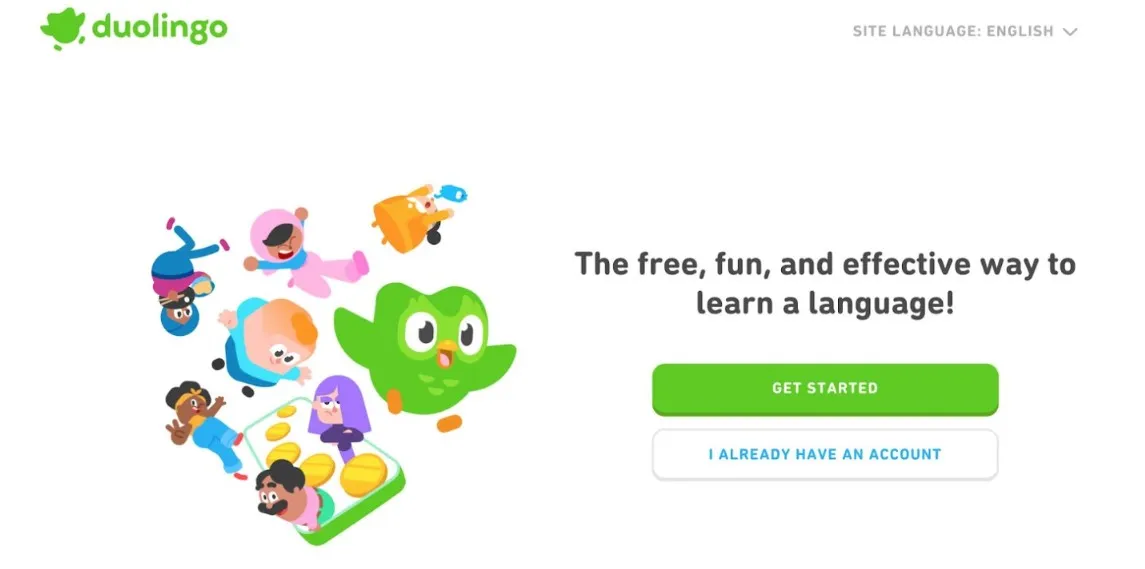
Duolingo is appealing to individuals who want to learn a new language in a fun and “non-boring” way. The app is great for people who have a casual interest in languages and may not be looking for a formal, intensive language-learning experience. Hobbyists who want to explore a new culture, prepare for a trip abroad, or simply enjoy the challenge of learning a new language, can also benefit from Duolingo’s entertaining approach.
Duolingo Pros
- Diverse Language Selection: Duolingo boasts a diverse array of languages to choose from, accommodating both widely spoken and less common ones. This breadth allows learners to explore languages of personal interest or practical value.
- Community and Interaction: Duoling fosters a sense of community through discussion forums and social features. Users can interact with fellow learners, ask questions, and share experiences, enhancing the overall learning journey.
- Progress Tracking: The app provides detailed progress tracking, allowing users to see their advancement in terms of skills mastered, lessons completed, and proficiency levels. This data-driven approach enables learners to set clear goals and monitor their improvement.
Duolingo Cons
- Superficial Language Knowledge: Duolingo’s bite-sized lessons may lead to a surface-level understanding of a language. Advanced fluency and complex language skills may require supplementary learning resources.
- Inconsistent Course Quality: Duolingo’s courses are created by contributors, which can result in varying quality across languages. Some courses may be comprehensive and well-structured, while others may lack depth and content.
- Overemphasis on Translation: Some exercises in Duolingo heavily rely on translation tasks, which may not always be the most effective method for acquiring practical language skills, especially in conversational contexts.
3. Memrise: Vocabulary enhancement for students and professionals
Like Duolingo, Memrise also employs a gamified learning style that incorporates elements such as points, streaks, and leaderboards to motivate users to continue their language learning journey. Users progress through levels, complete challenges, and earn rewards as they advance in their studies. But what makes the app unique is its use of mnemonic devices, such as vivid imagery and humor, to encourage faster vocabulary acquisition.
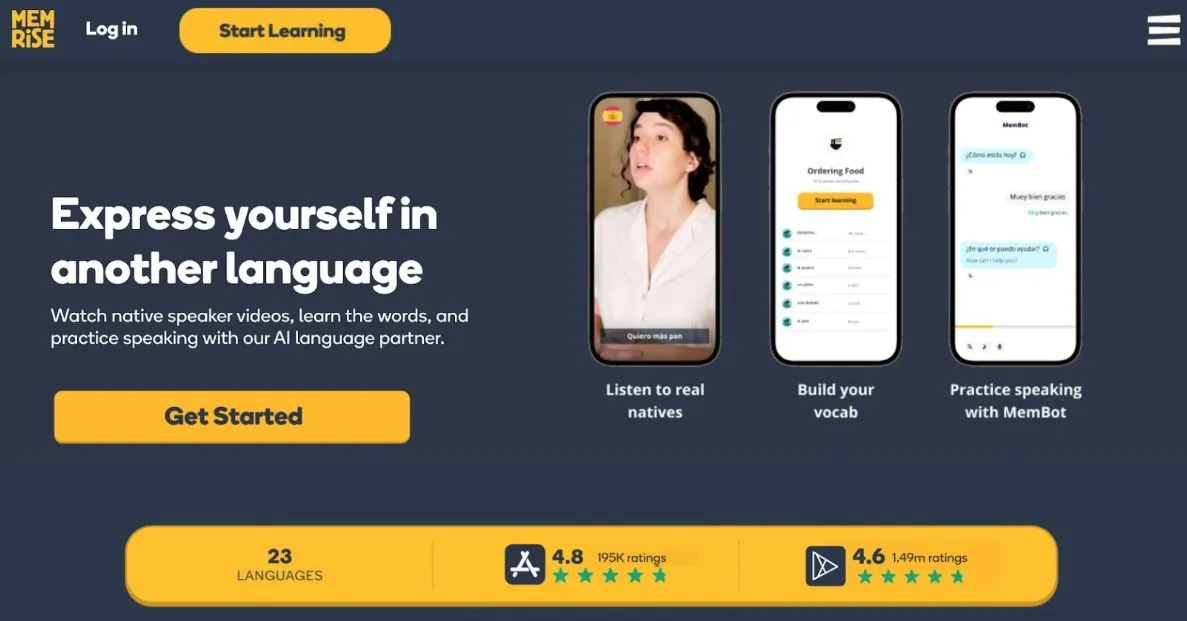
Because of its fun and light approach, Memrise can be attractive for students studying foreign languages, whether it’s for academic purposes or personal interest. It can help them expand their vocabulary, improve their reading and listening comprehension, and prepare for language exams.
Meanwhile, for professionals, the app’s extensive library of user-generated courses can aid in acquiring industry-specific terminology or improving language skills for effective communication. Whether it’s preparing for business meetings, presentations, or negotiations in a foreign language, Memrise can help professionals feel more confident and competent.
Memrise Pros
- Rich Audio Content: Memrise provides high-quality audio recordings of native speakers, enhancing learners’ pronunciation and listening skills. This feature goes beyond basic text-based vocabulary and contributes to a more immersive language learning experience.
- Multimodal Learning: The incorporation of visual aids, mnemonic techniques, and humor in Memrise courses makes the learning process engaging and multi-sensory. This approach caters to a variety of learning styles, especially those who thrive on visual and creative learning methods.
- Cultural Context: Some Memrise courses provide cultural insights and context alongside language learning. This inclusion helps learners gain a deeper understanding of the language’s cultural nuances, which is essential for effective communication in real-world scenarios.
Memrise Cons
- Lack of Grammar Emphasis: Memrise primarily focuses on vocabulary, often leaving grammar instruction as a secondary aspect. This limitation can hinder users from achieving complete language proficiency, as grammar is a crucial component of effective communication.
- Quality Control of User-Generated Content: The user-generated courses vary widely in quality, accuracy, and effectiveness. This inconsistency can lead to frustration for learners who rely on such content, as they may encounter subpar materials that hinder their progress.
- Overemphasis on Memorization: While memorization is a valuable aspect of language learning, Memrise’s heavy reliance on it may not align with all learning preferences. Some individuals may prefer more communicative and interactive language learning methods to apply their knowledge in practical situations.
4. Beelinguapp: Language learning for literature enthusiasts
Beelinguapp primarily focuses on reading and comprehension through a parallel-text method. It displays content in both the user’s native language and the target language side by side, accompanied by audio narration to aid understanding and pronunciation.
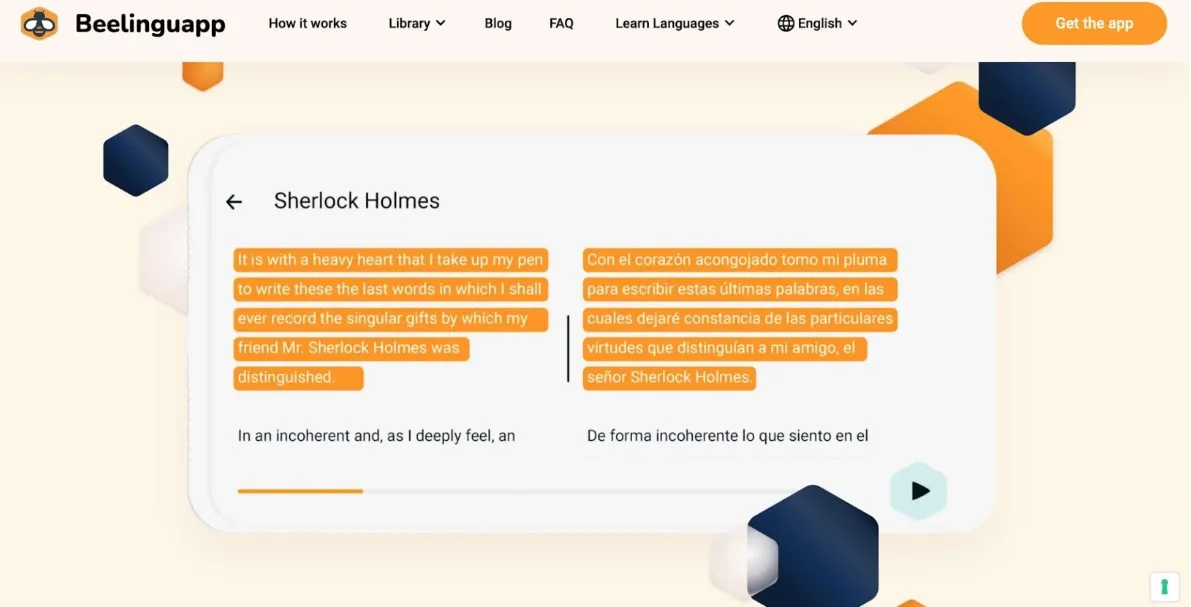
Because of its distinctive focus on reading, Beelinguapp can be especially appealing to literature enthusiasts aiming to enhance their vocabulary. It serves as a practical tool that offers a wide range of literary texts and cultural content. By engaging with content that interests them, literature enthusiasts can incrementally build their vocabulary through context and repeated exposure. The app also has a feature that allows users to focus on specific text sections for deeper understanding, encouraging regular and frequent use without becoming overwhelming.
Beelingual Pros
- In-Depth Cultural Immersion: By incorporating a range of culturally rich texts, Beelinguapp offers an immersion that goes beyond language, delving into cultural contexts which can enrich a learner’s understanding and appreciation of the language.
- Advanced Vocabulary Acquisition: For literature enthusiasts, the app’s inclusion of classic literature and complex texts can serve to significantly expand high-level vocabulary and understanding of literary styles and nuances.
- Cognitive Engagement: The act of comparing texts in two languages demands a higher cognitive load, which can lead to better retention and understanding of new vocabulary and structures within a literary context.
Beelingual Cons
- Limited Pedagogical Guidance: The lack of a structured learning path could result in a less systematic approach to vocabulary building, which might require learners to seek additional resources to fill in the gaps.
- Over Reliance on Reading/Writing Skills: The app’s focus on reading might not support the balanced development of all four language skills (reading, writing, listening, speaking), potentially leading to a lopsided proficiency.
- Inadequate Feedback Mechanisms: While the app provides quizzes, the feedback on performance might not be as detailed as needed for nuanced understanding of complex literary language and structures.
5. Anki: Custom study topics (e.g. medical students)
Anki is not your typical language learning app. In its essence, it’s actually a flashcard application that’s highly favored for language learning and various other subjects due to its spaced repetition systems (SRS)—which is designed to optimize memorization by scheduling reviews at increasing intervals, which effectively reinforces the memory just as it’s about to fade.
With Anki, you can create your own flashcards with text, images, audio, and even video. It’s highly customizable, enabling you to design card templates and adjust the algorithm settings to your personal learning space. Furthermore, the app supports add-ons which are community-created plugins that can extend the functionality of the application in numerous ways.
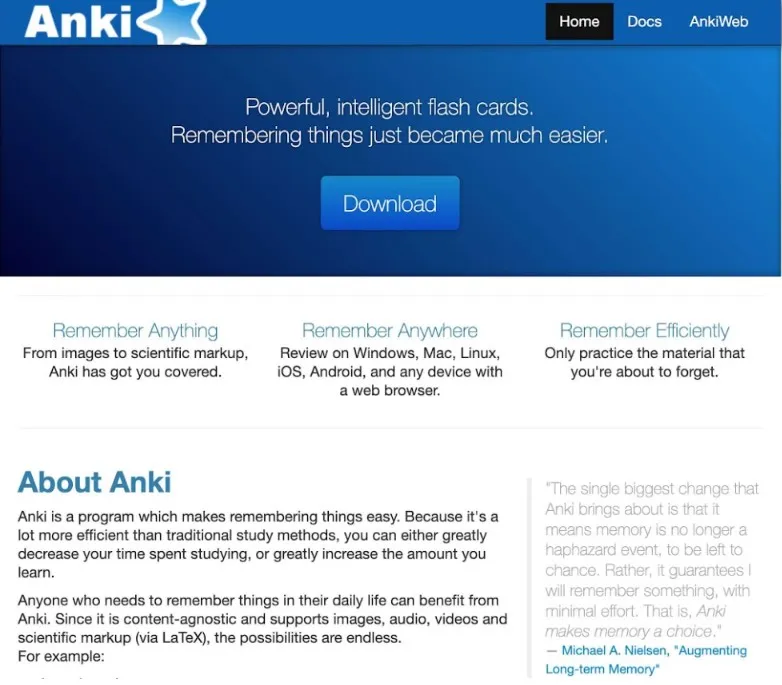
One of Anki’s strongest points is its custom study topics feature which is invaluable for students in rigorous academic fields, like medical students, who need to memorize vast amounts of information. They can create language learning decks tailored to specific subjects such as anatomy or pharmacology, and use tags to organize cards for review based on upcoming exams.
Anki Pros
- Advanced Customization for Efficient Learning: Users can tweak everything from card layout to the spaced repetition algorithm itself, optimizing their study sessions to match personal learning speeds and preferences.
- Cross-Platform Synchronization: AnkiWeb allows users to keep their progress up-to-date across multiple devices, from desktops to smartphones, ensuring continuity in the learning process regardless of location or device on hand.
- Shared Decks for Collaborative Learning: There is a plethora of decks available online created by other users, providing a collaborative platform where one can leverage the collective knowledge of the Anki community.
Anki Cons
- Complexity in Setup and Maintenance: Anki can be daunting for new users, with its array of options and settings requiring a significant investment of time to learn and configure effectively.
- Outdated User Interface: The interface can appear outdated and may not align with modern design standards, potentially affecting the user experience and making navigation less intuitive for new users.
- Potential for Cognitive Overload: The flexibility to add endless amounts of content can lead to overzealous card creation, resulting in an overwhelming backlog of cards to review and potential study burnout.
6. Drops: Quick vocabulary acquisition for travelers
Drops is another language learning app that uses the gamification approach. It includes over 350 bite-sized vocabulary lessons that incorporate swiping motions and animations to assist users in memorizing words. It focuses on generic vocabulary topics such as food, travel, and medicine, and provides a progress report to help learners track their development.
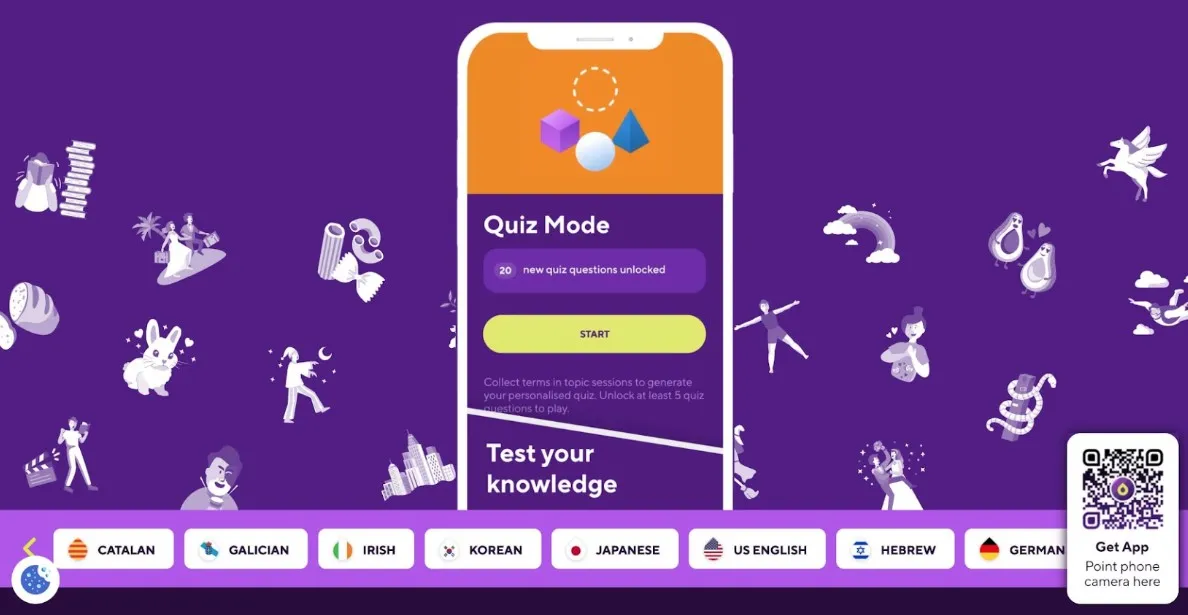
With Drops, travelers can learn essential phrases and words relevant to their travels, like greetings, directions, and food-related vocabulary. It can serve as a handy tool for those looking to enhance communication during short trips without really delving deep into grammar or conversation skills and long study sessions.
Drops Pros
- Tailored Learning Paths: Drops provides a tailored approach to vocabulary learning, with specialized topics that are aligned with the learner’s interests or needs, such as thematic vocabulary for business, hobbies, or culture-specific terms.
- Visual and Auditory Stimuli: The app combines high-quality graphics with native speaker audio clips, catering to both visual and auditory learning preferences, enhancing the recall abilities for users.
- Adaptive Difficulty Levels: Drops adapts to the user’s proficiency level, offering an increasing difficulty curve that ensures the learner is constantly challenged but not overwhelmed, promoting steady progress.
Drops Cons
- Limited Contextual Learning: While Drops excels at teaching individual words and phrases, it doesn’t provide much in the way of full sentences or conversational context, which can be a significant gap for learners wanting to use the language actively.
- No Synchronous Learning Opportunities: The app lacks features for synchronous learning, such as live tutoring or conversation practice, which could hinder the development of real-time language use skills.
- Repetition Without Depth: For some learners, the repetition that Drops focuses on might lead to superficial memorization rather than a deep understanding of word usage and nuances, particularly for complex languages.
7. Clozemaster: Refined sentence understanding for advanced learners
The name of the app comes from its distinct learning style. Clozemaster is based on “cloze” exercises, which are essentially fill-in-the-blank tests that help in learning, reinforcing, or testing language knowledge by requiring learners to supply missing words in sentences. These exercises also employ gamification to offer mass exposure to vocabulary within a contextual framework, making it a great follow-up tool to apps like Duolingo and Lingvist.
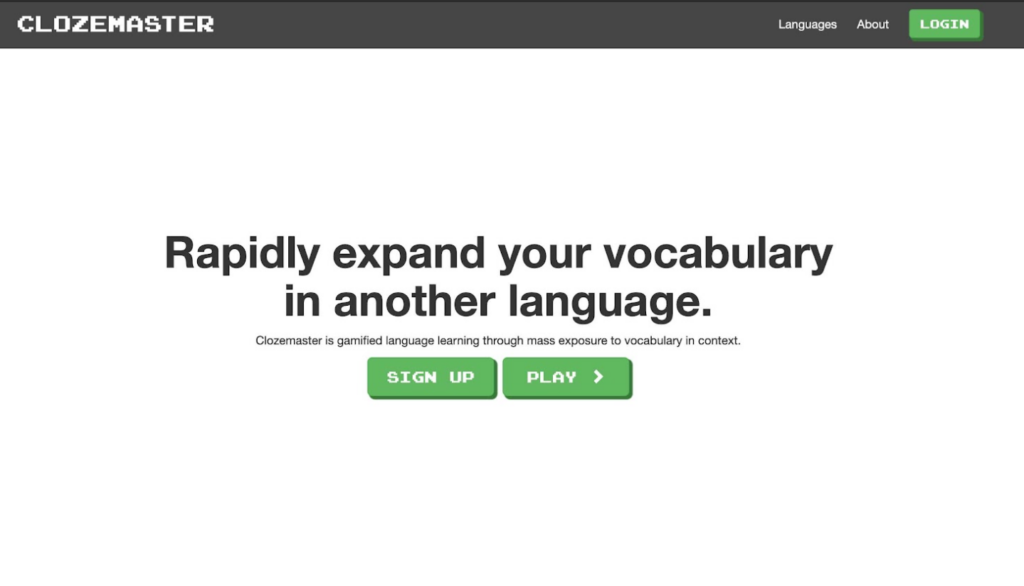
Beginners might find the app overwhelming as it’s designed for advanced learners especially those aiming to gain refined sentence understanding through context-rich vocabulary exercises. In exercises, learners are provided with missing words that they must fill in, either from multiple-choice options or by typing in the word directly. This sort of exercises require a prior knowledge of a certain language, hence, making it only suitable for those seeking further language education.
Clozemaster Pros
- Strategic Vocabulary Exposure: Clozemaster’s algorithm strategically selects vocabulary that learners are less likely to encounter frequently, effectively targeting the acquisition of more complex words. This method is based on frequency lists and ensures that the learner encounters these challenging words up to ten times per collection, solidifying their understanding and retention.
- Customization and Sharing: The Pro version of Clozemaster offers a customizable experience, allowing users to create and play with their own sentences. This feature not only personalizes the learning experience but also facilitates a community of learners who contribute to each other’s resources, potentially enhancing the variety and relevance of the learning material.
- Grammar-Specific Challenges: The app’s focus on grammar challenges is specifically beneficial for advanced learners looking to fine-tune their understanding of complex grammatical structures. By blanking out words according to common grammatical features, it provides targeted practice that can be crucial for achieving fluency.
Clozemaster Cons
- Aesthetic Learning Curve: The retro-themed design and font may not appeal to all users, potentially affecting the initial user experience until they adapt to the interface. This aesthetic choice can be a barrier to engagement for new users who prefer a more modern presentation.
- Fragmented Learning Context: The sentences offered are often unrelated to one another, lacking a cohesive narrative that might aid in comprehension and memory. This can lead to a disjointed learning experience where vocabulary is learned in isolation rather than as part of a larger, interconnected linguistic framework.
- Practical Relevance of Sentences: There is a possibility that some of the sentences provided are not pragmatically useful, meaning they may not be phrases that learners would typically use in daily conversations or practical situations.
8. LingoDeer: Structured lessons for beginners to intermediate learners
If you’re looking for a holistic learning experience, LingoDeer offers more than 200 structured lessons focusing on pronunciation, grammar, and vocabulary. It’s particularly known for its grammar-based curriculum designed to address crucial learning gaps, making it a comprehensive tool for both beginners and intermediate learners.
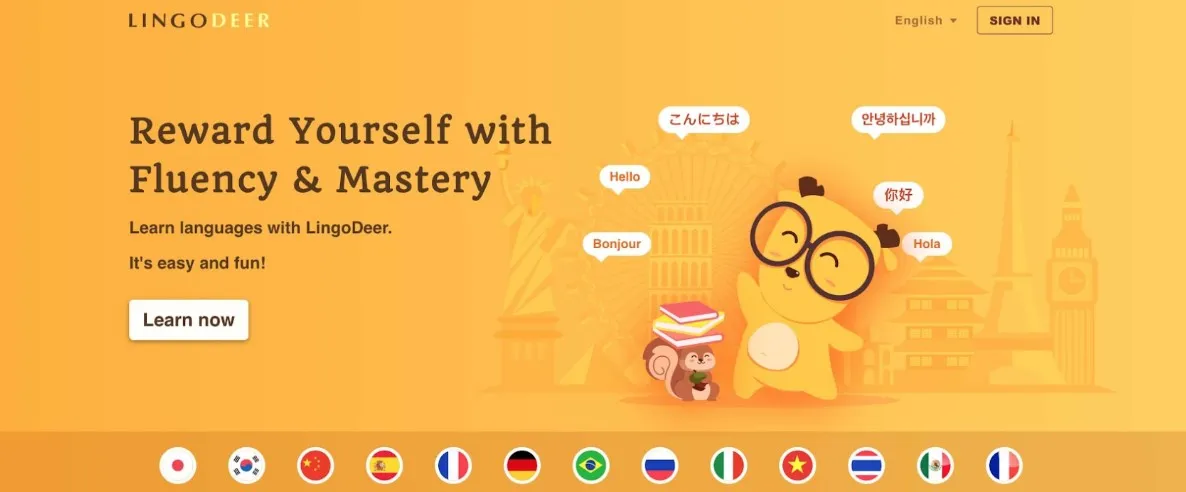
For someone starting with a foreign language, the app’s step-by-step approach can initially seem daunting, but with features like flashcards and a review tab, learners can pace themselves effectively. It’s especially beneficial for those planning to travel, as it includes a free Travel Phrasebook, and for students or professionals looking to enhance their proficiency for academic or career advancement.
LingoDeer Pros
- Specialization in CJK Languages: The app is particularly adept at teaching Chinese, Japanese, and Korean, offering a tailored experience that addresses the unique challenges of these languages.
- Comprehensive Language Range: Beyond CJK languages, LingoDeer covers a total of 12 languages, offering breadth and depth in language learning.
- Engaging Language Community: The growing community of language enthusiasts offers a supportive environment for practice and cultural exchange.
LingoDeer Cons
- Initial User Experience Complexity: New users may find the app’s interface and structure less intuitive, requiring a period of adjustment to effectively navigate and utilize its features.
- Early Testing Challenges: The app’s early testing approach can be overwhelming for beginners who are not yet familiar with the language’s alphabet or basics.
- Hidden Features: Some beneficial features like flashcards are not immediately evident, which can hinder learners from taking full advantage of all available tools.
9. 50Languages.com: Basic phrases for travelers
As the name suggests, this language learning app provides users the opportunity to learn 50 languages that might not be extensively covered in other language programs. Lessons center on basic vocabulary and grammar, emphasizing practical and everyday language use. These lessons also incorporate audio tools, allowing learners to hear native pronunciation and intonation.
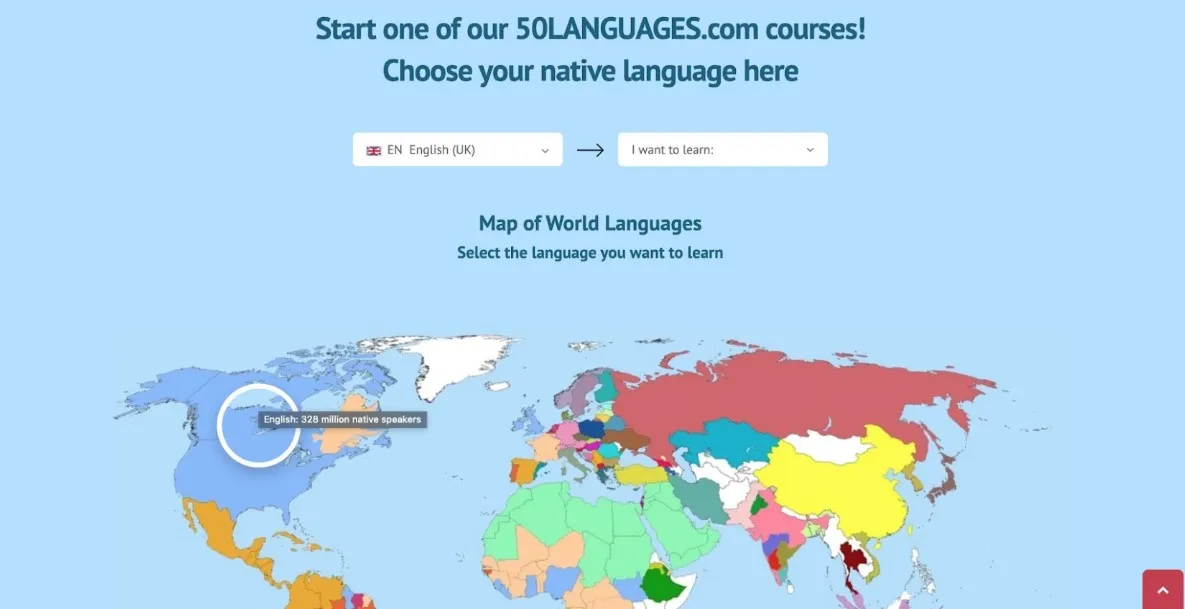
50languages focuses on basic phrases and essential vocabulary that can be vital for navigating in a foreign country. This includes phrases for greetings, dining, directions, and shopping, which are crucial for travelers. The audio components can also help travelers learn correct pronunciation, which is important for effective communication in a new country.
50Languages.com Pros
- Authentic Audio Resources: The inclusion of native speaker audio recordings offers learners an authentic experience in pronunciation and intonation, a critical factor in mastering a language.
- User-Friendly Interface: The platform’s design is straightforward and intuitive, accommodating users of varying ages and technical backgrounds, which enhances the learning experience.
- Learning from Various Base Languages: Unlike many language learning apps that primarily use English as the base language, 50languages allows users to learn a new language from a variety of base languages, making it more globally inclusive.
50Languages.com Cons
- Limited Depth for Advanced Learning: The platform mainly focuses on basic phrases and vocabulary, which might not suffice for learners aiming for advanced proficiency or in-depth understanding of a language.
- Potential Monotony in Lessons: The repetitive nature of lessons, crucial for memorization, might become tedious over time for some learners, potentially affecting motivation and engagement.
- Unclear Progression Path: The platform does not provide a structured learning path from beginner to advanced levels, which might leave learners uncertain about their progress and next steps.
10. FluentU: Real-world content for media enthusiasts
If you want an immersive experience, FluentU incorporates a variety of authentic content, such as music videos, movie trailers, news, and inspiring talks. This method enables you to experience and understand new languages in their natural context, significantly enhancing your real-world comprehension and language application skills. Besides videos, the app features other vocabulary learning tools like flashcards, quizzes, speech recognition for pronunciation practice, and personalized learning paths that adapt to individual proficiency levels.

FluentU is a no-brainer for media enthusiasts that are auditory and visual learners. It allows them to delve into cultural aspects of their target language with subtitled content, which helps them in understanding linguistic nuances.
FluentU Pros
- Tailored Learning Experience: Algorithms adapt to user interactions, providing content that suits individual learning styles, speeds, and interests, making the learning journey more personalized.
- Cultural and Idiomatic Insights: Exposure to colloquial language, slang, and cultural references provides a deeper understanding of the language beyond textbook learning.
- Flexible Learning Structure: Unlike traditional courses, FluentU allows users to choose what they want to learn and when, catering to both structured and exploratory learning styles.
FluentU Cons
- Language Selection Limitation: The platform doesn’t support as many languages as some of its competitors, limiting options for learners interested in less commonly taught languages.
- Lack of Traditional Grammar Instruction: FluentU’s approach may not adequately cover detailed grammar rules, which could be a drawback for learners who prefer explicit grammar instruction.
- Limited Direct Speaking Practice: While it offers pronunciation tools, there’s a lack of interactive, conversational speaking practice, which is crucial for developing conversational fluency.
11. HelloTalk: Making international friends and cultural exchange
HelloTalk connects you to other language learners from around the world. Unlike most language learning apps, it facilitates real-time communication with native speakers giving you the opportunity to practice a new language in a natural and interactive way.
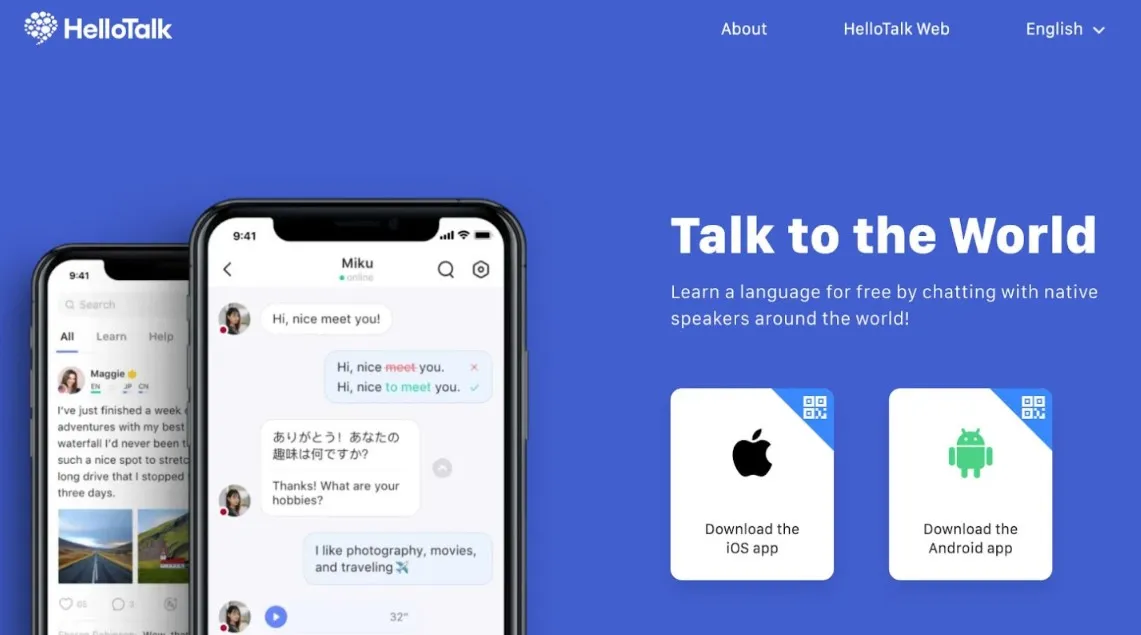
The app works by pairing you with native speakers of your target language. Then, it provides you with features that will help make your language learning experience more productive such as text and voice messages, video and audio calls, group chats, translation tools, pronunciation aids, and grammar correction. It also has a social media-like feature where you can share updates or ask questions to the community.
HelloTalk offers more than just language learning. It allows you to make friends and appreciate various cultures. By engaging in meaningful conversations with people from different countries and cultures, you can gain a deeper understanding and appreciation of their cultures.
HelloTalk Pros
- Spontaneous Conversation Practice: Encourages impromptu, real-time conversations that can better prepare learners for real-world scenarios, unlike scripted dialogues in traditional learning environments.
- Cultural Nuances and Slang: Users gain exposure to contemporary slang, idioms, and cultural references that are often not covered in textbooks, enhancing their understanding of the language in its current, everyday use.
- Feedback from Multiple Sources: The opportunity to receive feedback and corrections from various native speakers provides a broader range of insights into language use, pronunciation, and grammar.
HelloTalk Cons
- Quality of Language Feedback: Given that not all native speakers are skilled teachers, the quality of feedback and instruction can be inconsistent and sometimes inaccurate.
- Cultural Misunderstandings: Interacting with users from different cultural backgrounds can sometimes lead to misunderstandings or unintended offense, particularly for those not well-versed in the nuances of the target culture.
- Potential for Uneven Language Exchange: Some users may find that conversations are dominated by one language over the other, making it a challenge to get equal practice in both languages.
12. Tandem: Language exchange and tandem learning
Tandem shares some similarities with HelloTalk, but many users find it more laidback. It features a clean and straightforward interface that removes the overwhelm for those who are new to language exchange. It equips learners with the most essential learning tools, encouraging them to engage in natural conversation—instead of having a structured experience.
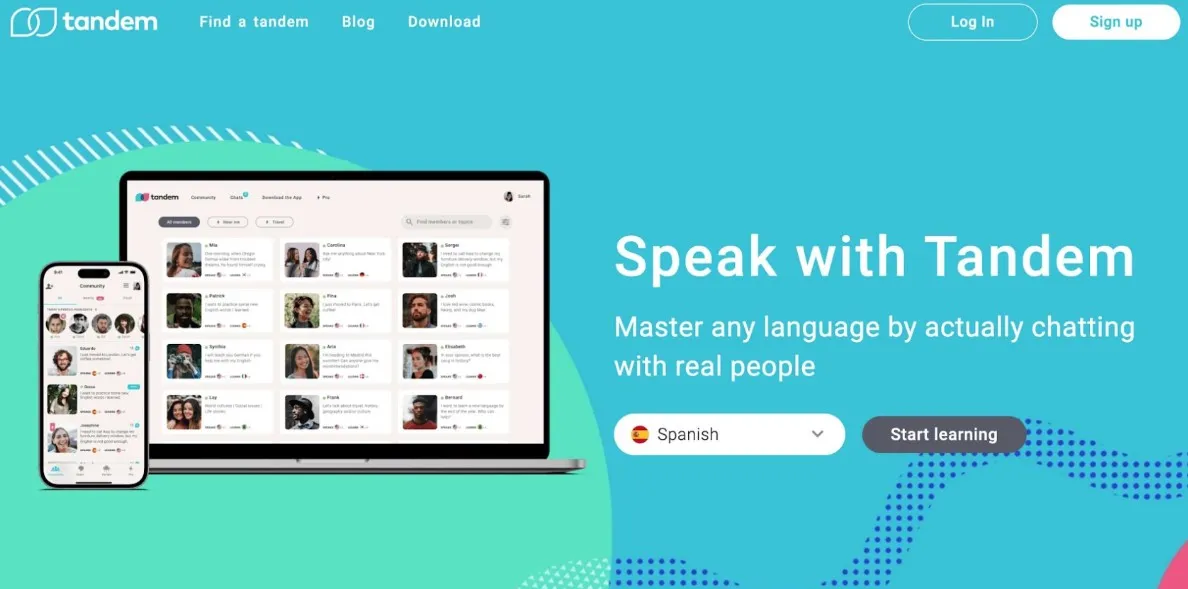
Using Tandem is as easy as 1-2-3. First, you are required to create a profile indicating your native language, the language you wish to learn, and your proficiency level. The app then suggests potential language exchange partners based on these preferences. Once connected, users can engage in conversations via text, voice, or video calls.
Through language exchange with native speakers, you can gain insight into their culture, traditions, and everyday life. Furthermore, engaging in regular conversations with native speakers can help enhance your fluency and pronunciation, and texting can help improve your writing and comprehension skills.
Tandem Pros
- Diverse Language Partners: Access to a global user base allows for connecting with speakers of rare or less commonly taught languages, not just widely spoken ones.
- Social Networking Opportunity: Beyond language learning, Tandem offers a platform for making international friends, which can lead to lifelong friendships and cross-cultural connections.
- Flexible Scheduling: The app accommodates users’ varied schedules, allowing for language practice at any time, catering to different time zones and lifestyles.
Tandem Cons
- Inconsistent Learning Pace: Dependence on partners’ availability and commitment can result in irregular learning sessions, affecting language progression.
- Varied Skill Levels of Partners: The disparity in language skills between partners can sometimes hinder effective communication and learning.
- Risk of Ineffective Pairings: The success of language exchange heavily relies on finding the right partner, which can be a hit-or-miss experience.
Conclusion
The journey of learning a new language extends far beyond mere personal enrichment. It opens up a world of cognitive benefits, enhances professional prospects, and invites us into the heart of diverse cultures. The ability to communicate in another language is not just a skill—it’s a key that unlocks doors to new perspectives, connections, and opportunities.
With these invaluable free resources at your fingertips, the journey to multilingualism no longer has to be hindered by financial constraints. The path to acquiring a new language is now more accessible than ever. We encourage you, our readers, to seize this opportunity.
Choose the app that aligns with your learning style and begin your adventure into the world of languages. As you embark on this enriching journey, remember that each new language you learn not only brings the world closer but also broadens your personal horizons in ways you never imagined.



